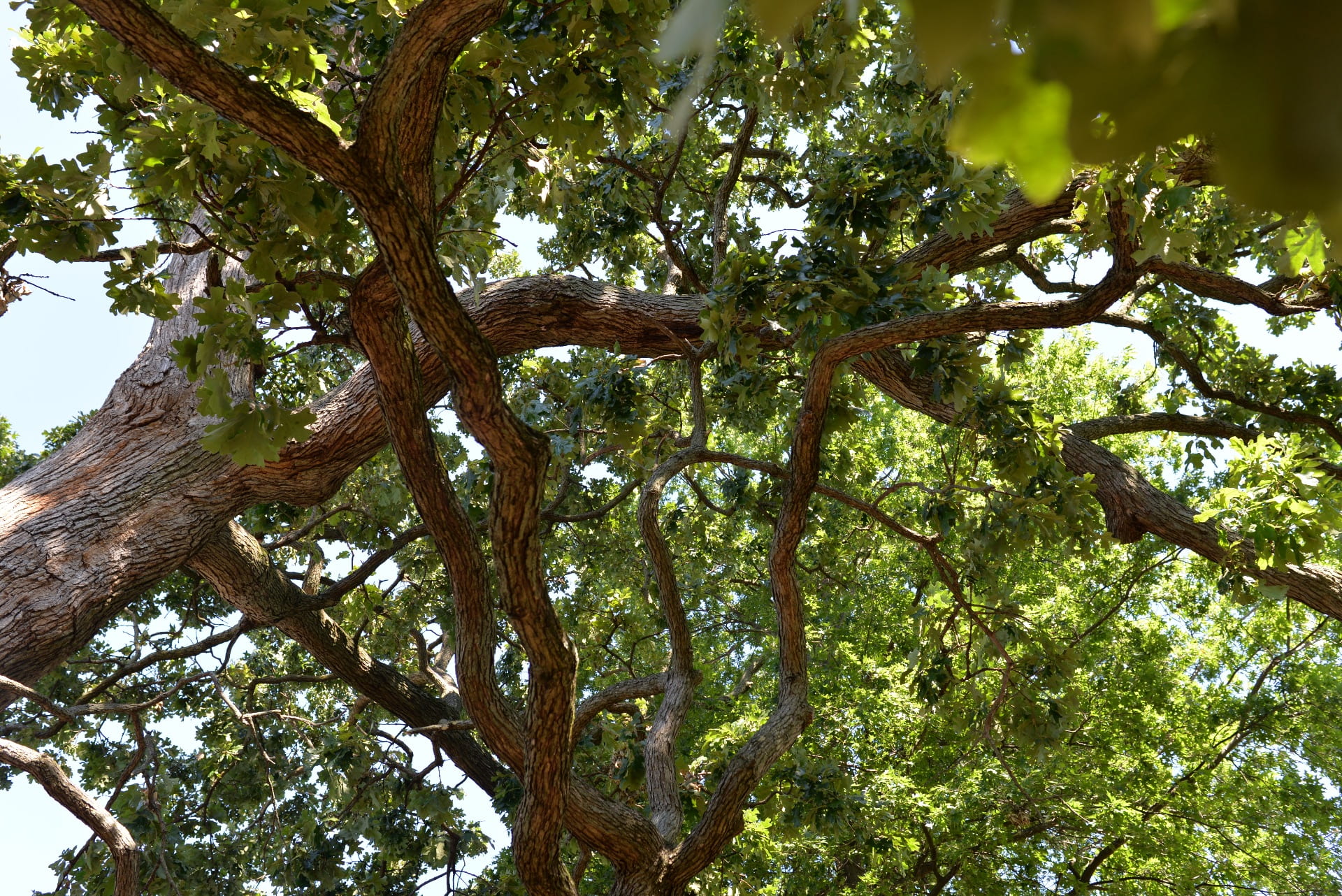Post Oak
Arbor walk #68, TreeKeeper ID #2930

The Post Oak is a North American species in the white oak group. This tree is easily recognizable by the unique cross shape formed by the leaf lobes. The Post Oak, sometimes called the iron oak or rough oak, is native to the eastern and central regions of the United States. It is fairly low maintenance and capable of growing in various types of soils. The second part of the Latin name, stellata, means “star”, which is most likely a reference to the shape that is formed by the lobes. Our post oak is one of the oldest tree specimens remaining on the South 40. It was recently saved from creeping vines which were strangling the tree, the remnants of which can still be observed on the tree today.
The Overcup Oak is a member of the subgenus of white oaks. These oaks are distinguishable from other oaks from their smooth lobe tips (no awns), their hairless leaf undersides, and their lighter, flakier bark. The acorns of white oaks are also less tannic, meaning that they require less processing to become safe and palatable.

GPS Coordinates
N/A
Percent Concrete
N/A
Distance to Buildings
| Year | Close Building #1 | Close Building #2 | Close Building #3 |
|---|---|---|---|
| 2020 | Alumni House, 18.93 m | Koenig House, 36.08 m | Gregg House, 69.57 m |
Distance to Other Species
| Year | Close Species #1 | Close Species # 2 | Close Species # 3 |
|---|---|---|---|
| 2020 | Eastern Arborvitae, 3.62 m | American Holly, 4.65 m | Pin Oak, 8.52 m |
Standard Measurements
| Year | Height (m) | DBH (cm) | Caliper (m) | Crown Diameter N-S (m) | Crown Diameter E-W (m) | Average Crown Diameter (m) |
|---|---|---|---|---|---|---|
| 2020 | 19.4086 | 92.99 | N/A | 19.13 | 13.5 | 16.315 |
| 2023 | 21.12 | 92.5 | N/A | 15.1 | 17.9 | 16.5 |
| 2024 | 26.47 | 93 | N/A | 16.2 | 17.8 | 17.05 |
Nests and Pests
| Year | Description |
|---|---|
| 2020 | A large fungal growth at the base of the tree shaped like butt rot but appears woody Many large lower branches were covered in moss, green lichen, and algae Large woody vines had crept all the way up the tree, though they’ve been cut long ago and are now dead |
Leaf Identification
The leaves of the Post Oak range from 3″ to 6″ in length, with the shape of a lowercase “t” accentuated by large lobes at the tip and smaller lobes at the base, 5-7 lobes in total. The leaves are arranged alternately on the stem, and the leaf is simple (no leaflets).
Twig and Bud Identification
The twig turns matures from green to tan brown, with numerous pale lenticels (pores) along the surface. When immature, the twig is pubescent. Buds are borne terminally and axillary (between twig and leafstalk); the terminal buds are clustered. The buds are many-scaled and reddish-brown to reddish-tan.
Bark Identification
The bark has multiple layers of thick, narrow vertical scales that can flake off. The scales create small vertical fissures.
Fruit Identification
The acorn of the Post Oak reaches 1″ in length and has a relatively deep cup, which can cover half of the acorn. The cup has many overlapping triangular thin scales, and the acorn itself may have vertical stripes.
Flower Identification
The flowers of the Post Oak are monoecious; both male and female flowers are present, separately, on the same tree. The staminate (male) flowers are hanging yellow catkins (long, slender clusters of unisexual flowers). The pistillate (female) flowers are inconspicuous, greenish, and solitary on the twig.
Oak ID Tips
- Compared to other oaks with three prominent lobes near the tip, like the Overcup Oak or Blackjack Oak, the Post Oak has wider, blocky lobes and shallower sinuses than the Overcup Oak. Unlike the Blackjack Oak, the Post Oak has additional lobes near the base of the leaf.
- Although the Bur Oak could have leaves that appear to be like those of the Post Oak, its leaves are much larger than those of the Post Oak, and with more rounded toothing than the blocky Post Oak leaves.












